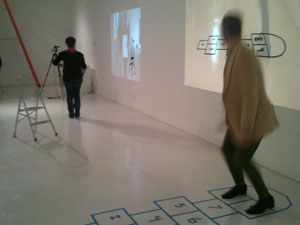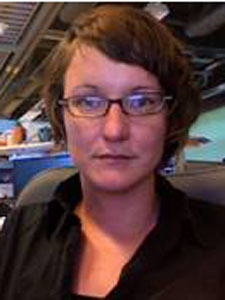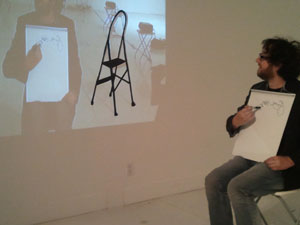'Performing Wendy Clarke' Explores Early Notions of Virtual Reality
San Diego, Calif., Feb. 23, 2011 — As Calit2’s Tour Director and Gallery Coordinator at UC San Diego, Trish Stone explores the outer reaches of virtual reality using some of the most advanced, immersive and high-resolution 3D visualization technologies in the world.
|
So when the opportunity presented itself in the form of a performance series at the UCSD University Art Gallery, Stone (who is also a professional exhibiting artist) couldn’t resist exploring some of the same concepts that underpin virtual reality — interactivity, disorientation, tweaking of the physical space — using nothing but a video camera, a standard digital projector and a few basic props.
Stone’s piece, “Performing Wendy Clarke,” debuted at the UAG last week and was inspired by the work of video artist Wendy Clarke, who presented an interactive video installation at the gallery in 1977. Clarke is best known for her “Love Tapes,” a series of more than 800 short videotapes in which she documents peoples’ individual definitions of the meaning of love.
For her “Interactive Video” piece at the UAG three decades ago, Clarke typed up a set of “instructions” that encouraged the public to interact with a set of standard television monitors rather than the physical space of the gallery. “Stand between the two monitors, which have playing fields on them,” read her instructions for “Hopscotch.” “Play a regular game of hopscotch, but judge your moves on the monitors, not the floor.”
|
Stone says the intention behind her reinterpretation of Clarke’s work was “to look at it from the context of 2011 and to look at her concepts, which I think were really strong.
“Her concepts were about interactivity and about video as a unique medium," she continues. "I thought I could apply them to what we’re doing today at Calit2. My job at Calit2 is to work in the virtual reality labs running demos of 3D virtual reality, high-resolution virtual reality and videoconferencing that aims toward a sense of telepresence. A lot of what we do is high-end in terms of the technology we use and the cost involved in building all the devices. I wanted to see if I could address those same concerns but in a very simple, no-budget way, which is why I stuck with one camera and one projector.”
Stone, who considers Clarke’s work a “forerunner of virtual reality,” set up her performance much the same way Clarke had. For the “self-portrait” component of the piece, she asked visitors to the gallery to draw pictures of themselves while looking into a video camera and using a video projection as a “mirror.”
“This brings attention to spatial anomalies between what Wendy Clarke calls ‘video space’ and ‘real space,’” says Stone. “The modern parallel is that instead of drawing a self-portrait, you’re now drawing an avatar. Interacting in Clarke’s concept of video space is very much like having a videoconference. In terms of the physical dynamics, it’s all a little bit stranger, so you’re aware of the discrepancies between video space and real space.”
Stone’s performance was part of a larger series at the UAG called “Archive Fever,” which was organized by several UCSD faculty, including Calit2-affiliated Associate Professor of Visual Arts Ricardo Dominguez. The series was intended to explore — through poetry, performance and dance — the history of the UAG’s exploration into performance art under the guiding influence of former Gallery Director David Antin. Artists were invited to mine the gallery’s archives for inspiration, with each choosing to reinterpret work by artists who exhibited in the space during the ‘60s, ‘70s and ‘80s.
|
Although Stone didn’t strictly follow Clarke’s written “instructions,” she did recreate the five aspects of Clarke’s performance using a single camera and single projector (in place of two television monitors). For Clarke’s “stair” piece, for example, Stone projected an image of stairs onto a wall and asked participants to walk up a stepladder while only looking at the projected image. For the “chairs” component, Stone set up two chairs and pointed a camera at them, and then asked two participants to interact with one another only by looking at projected images of themselves.
“Some of the fun things you discover when playing with virtual reality is that it’s a lot like real space, but it’s slightly different and jarring in ways you wouldn’t expect,” notes Stone. “Those are the moments I’m interested in exploring further -- how virtual reality affects the way you experience your real life. When you’re in the Calit2 StarCAVE,” an immersive VR environment, “and you experience the virtual walkthrough of Calit2, when you leave the CAVE and you walk down the hall you were just walking down in virtual reality, it feels slightly unreal. It’s that sense of unreality that I was going for.”
Archive Fever will continue at the UAG every Thursday and Friday night through March 18. For more information, visit the UAG website.
Related Links
Media Contacts
Tiffany Fox, (858) 246-0353, tfox@ucsd.edu



